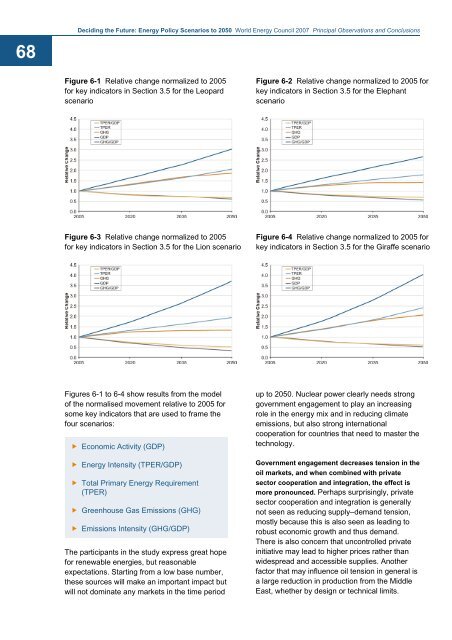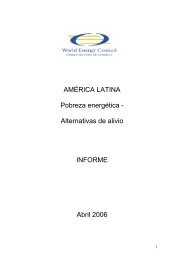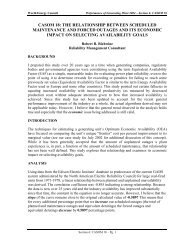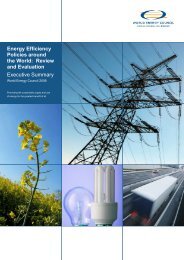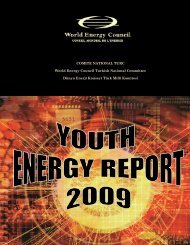Deciding the Future: Energy Policy Scenarios to 2050
Deciding the Future: Energy Policy Scenarios to 2050
Deciding the Future: Energy Policy Scenarios to 2050
You also want an ePaper? Increase the reach of your titles
YUMPU automatically turns print PDFs into web optimized ePapers that Google loves.
68<br />
<strong>Deciding</strong> <strong>the</strong> <strong>Future</strong>: <strong>Energy</strong> <strong>Policy</strong> <strong>Scenarios</strong> <strong>to</strong> <strong>2050</strong> World <strong>Energy</strong> Council 2007 Principal Observations and Conclusions<br />
Figure 6-1 Relative change normalized <strong>to</strong> 2005<br />
for key indica<strong>to</strong>rs in Section 3.5 for <strong>the</strong> Leopard<br />
scenario<br />
Figure 6-2 Relative change normalized <strong>to</strong> 2005 for<br />
key indica<strong>to</strong>rs in Section 3.5 for <strong>the</strong> Elephant<br />
scenario<br />
Figure 6-3 Relative change normalized <strong>to</strong> 2005<br />
for key indica<strong>to</strong>rs in Section 3.5 for <strong>the</strong> Lion scenario<br />
Figure 6-4 Relative change normalized <strong>to</strong> 2005 for<br />
key indica<strong>to</strong>rs in Section 3.5 for <strong>the</strong> Giraffe scenario<br />
Figures 6-1 <strong>to</strong> 6-4 show results from <strong>the</strong> model<br />
of <strong>the</strong> normalised movement relative <strong>to</strong> 2005 for<br />
some key indica<strong>to</strong>rs that are used <strong>to</strong> frame <strong>the</strong><br />
four scenarios:<br />
Economic Activity (GDP)<br />
<strong>Energy</strong> Intensity (TPER/GDP)<br />
Total Primary <strong>Energy</strong> Requirement<br />
(TPER)<br />
Greenhouse Gas Emissions (GHG)<br />
Emissions Intensity (GHG/GDP)<br />
The participants in <strong>the</strong> study express great hope<br />
for renewable energies, but reasonable<br />
expectations. Starting from a low base number,<br />
<strong>the</strong>se sources will make an important impact but<br />
will not dominate any markets in <strong>the</strong> time period<br />
up <strong>to</strong> <strong>2050</strong>. Nuclear power clearly needs strong<br />
government engagement <strong>to</strong> play an increasing<br />
role in <strong>the</strong> energy mix and in reducing climate<br />
emissions, but also strong international<br />
cooperation for countries that need <strong>to</strong> master <strong>the</strong><br />
technology.<br />
Government engagement decreases tension in <strong>the</strong><br />
oil markets, and when combined with private<br />
sec<strong>to</strong>r cooperation and integration, <strong>the</strong> effect is<br />
more pronounced. Perhaps surprisingly, private<br />
sec<strong>to</strong>r cooperation and integration is generally<br />
not seen as reducing supply–demand tension,<br />
mostly because this is also seen as leading <strong>to</strong><br />
robust economic growth and thus demand.<br />
There is also concern that uncontrolled private<br />
initiative may lead <strong>to</strong> higher prices ra<strong>the</strong>r than<br />
widespread and accessible supplies. Ano<strong>the</strong>r<br />
fac<strong>to</strong>r that may influence oil tension in general is<br />
a large reduction in production from <strong>the</strong> Middle<br />
East, whe<strong>the</strong>r by design or technical limits.


